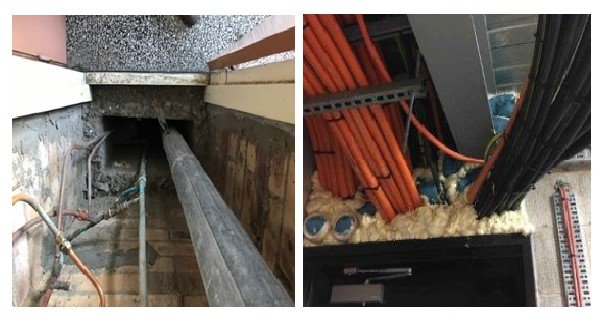So which penetration is worse?
In our opinion, it’s the open penetrations that we see in way too many places, sometimes we are scared to open a service cupboard. Our concern is the blatant open holes that are not even treated, for example like the one above an open floor penetrations in a riser.
There are actually positives with the other one (not sure where I got that photo) it would most likely hold back a fire for a little while for the integrity component, might fail insulation criteria however, in most cases even the good old fire foam will keep back smoke, the biggest killer.
We all see many photos of terrible penetrations gracing social media, the vast majority are not compliant, and highlights terrible workmanship and a lack of understanding, however still better than nothing.
A few examples, how about Party walls missing in roof space negating any chance of compartmentation.
Or in the case of a full opening above a fire door (Yes, the door was certified).
Sadly, as passive fire certifiers, we see a lack of knowledge on site and a rampant belief that goop or expandable foam will simply fix it. Or worse still, just sheet it, nobody will see.
Building foremen should at least know the basics of passive fire, instead of just passing responsibility onto subcontractors. As I see it, they are the eyes onsite and unknowingly many are exposing their employers to the potential of huge repair cost or litigation possibly even many years later.
In light of recent disasters, and the ongoing non-compliance we see, maybe it’s time for mandatory industry wide passive fire awareness upskilling.
This could start with every trade during their apprenticeship to highlight the importance of fire stopping and why the compartmentation process is essential.
For more information give us a call on 1800 PASSIVE.




